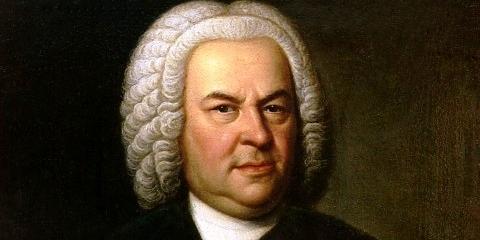MCO’s Bach Suites can be heard in Melbourne on Thursday 22 November at The Deakin Edge, Federation Square and Sunday 25 November at Melbourne Recital Centre.
Johann Sebastian Bach
Orchestral Suite No 3 in D major BWV 1068
Orchestral Suite No 4 in D major BWV 1069
Concerto for two violins in D minor BWV 1043
In the entry on Johan Sebastian Bach (1685-1750) in the Grove Dictionary of Music, Christoph Wolff and Walter Emery state that “his genius combined outstanding performing musicianship with supreme creative powers in which forceful and original inventiveness, technical mastery and intellectual control are perfectly balanced. While it was in the former capacity, as a keyboard virtuoso, that in his lifetime he acquired an almost legendary fame, it is the latter virtues and accomplishments, as a composer, that by the end of the 18th century earned him a unique historical position. His musical language was distinctive and extraordinarily varied, drawing together and surmounting the techniques, the styles and the general achievements of his own and earlier generations and leading on to new perspectives which later ages have received and understood in a great variety of ways.” This introductory statement encapsulates so much of what has been written about JS Bach and the monumental impact his work has had on the development of Western music.
The four Orchestral Suites BWV 1066–1069 were composed between 1725 and 1739, with Suite No 2 being the last composed in 1739 (contrary to the BWV catalogue number). These virtuosic instrumental compositions were likely to have been written in Leipzig for the University Collegium Musicum. Bach gave the works the title Ouverture which also is the title of the opening movement and is in the French style (with its stately and rhythmically marked first section, contrasted with a fast contrapuntal section before a return to the slow final section). Following the opening movement there is a series of French dances that were popular in Germany at the time.
Suite No 3 in D major BWV 1068 (1725) commences with the Ouverture followed by the Air scored for strings and continuo. This Air is possibly one of the most famous single movements in Bach’s output, mainly in part through the popularity of the arrangement by August Wilhelmi (1845-1908) as Air on the G string. This elegant movement is followed by a pair of Gavottes, a Bourée, and concludes with a Gigue. The Suite is scored for two oboes, three trumpets, timpani, two violins, viola, and basso continuo.
In 1730 Bach composed Suite No 4 in D major BWV 1069 scored for three oboes, bassoon, three trumpets, timpani, violin I and II, viola, and basso continuo. Like its predecessor it opens with an Ouverture, and is followed by two Bourées, a Gavotte, two Menuets, and concludes with Réjouissance with its festive rejoicing.
The Concerto for two violins in D minor BWV 1043 dates from 1730. The work was composed around the time of the concertos for violin in A minor and E major. It is likely that all of these works would also have been composed for the Collegium Musicum in Leipzig. In 1739 Bach arranged the D minor concerto as a concerto for two harpsichords in C minor BWV 1062.
Scored for two violins, strings and basso continuo the three movements follow the pattern of fast, slow, fast. The opening Vivace presents a swirl of exciting contrapuntal writing. The Largo ma non troppo provides us with an example of Bach providing a magical and poignant contemplation. And the Allegro finale jolts us out of the reverie towards an exciting conclusion. The interplay of the two violins with each other and the strings conveys some of Bach’s most exquisite music.
David Forrest
Richard Mills
Concerto for Two Violins and String Orchestra
The composer writes:
This work was commissioned by Bill Hennessy and the Melbourne Chamber Orchestra with financial assistance from the Australia Council for the Arts and the Robert Salzer Foundation.
The occasion of this premiere is something of a commemoration. As I approach a “significant” birthday, I realise that I have worked with Bill for over 40 years, at the Tasmanian Symphony Orchestra, at the Adelaide Chamber Orchestra, both before and after I became its Artistic Director, at ANAM, accompanying his wonderfully talented students, at the Australian String Quartet via my first String Quartet, in writing for the Australian Octet—and now, via this project, at the splendid Melbourne Chamber Orchestra, which offers so many opportunities to the developing professionals of this city and contributes so substantially to its culture. Bill is a national treasure—an outstanding contributor to the musical life of Australia as a performer, teacher and artistic director—so I appreciate the opportunity to offer this piece as a testament to our long friendship and as a way of saying thanks.
Perhaps Bill realised that there were no Australian double concerti for two violins—and wished to add to the repertoire, in the same way that the recent octets he has commissioned have been able to do. Hopefully this work will fill a need and be a useful, programmable and playable piece for our violinists.
The Concerto is in the traditional three sections. The Fantasia is the most developed movement: contrasting ideas unfold in different tempo relationships, including accompanied cadenzas with free and fixed elements. The Canzona is just that—a song and the Danza revels in the joy of irregular meters common to Greek and Turkish music—just the sort of thing you might hear when walking the the dog in Brunswick on Friday night. Enjoy.

